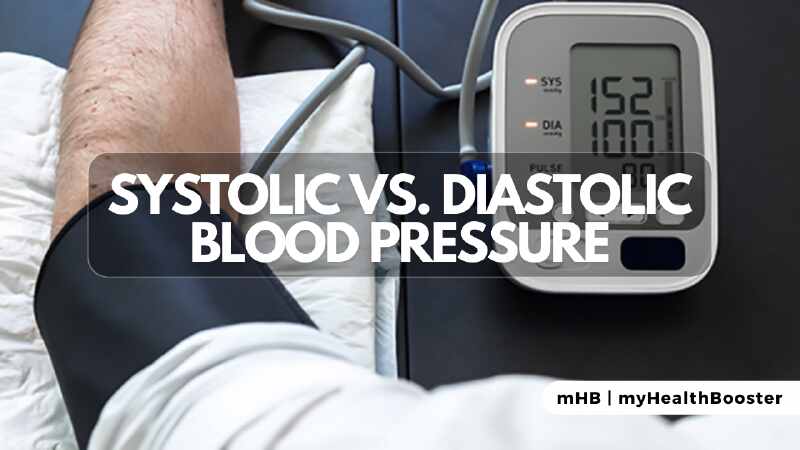Systolic and diastolic blood pressure readings play a vital role in understanding cardiovascular health. Systolic pressure reflects the force of blood when the heart contracts, while diastolic pressure indicates the resting phase between beats. These values, usually around 120/80 mm Hg, are critical in evaluating cardiovascular well-being. Deviations from the norm may signal health conditions like hypertension or hypotension. Regular monitoring is key for early detection and effective management of potential cardiovascular issues.
In this article, we delve into the distinctions between systolic and diastolic blood pressure, unravel their significance in assessing cardiovascular health, and provide insights into maintaining a healthy blood pressure range.
Systolic vs Diastolic Blood Pressure
Let’s demystify the basics of systolic and diastolic blood pressure.
Systolic Blood Pressure (SBP): SBP measures the maximum pressure exerted by the blood on arterial walls during the heart’s contraction (systole). Represented as the higher of the two values, it is measured in millimeters of mercury (mmHg). For instance, in a reading of 120/80 mmHg, 120 is the systolic blood pressure.
Diastolic Blood Pressure (DBP): DBP reflects the minimum pressure in the arteries during the heart’s resting phase between beats (diastole). Represented as the lower of the two values, it is measured in mmHg. In the same example, 80 is the diastolic blood pressure.
Significance of Systolic and Diastolic Blood Pressure
Appreciating the significance of both systolic and diastolic blood pressure aids healthcare professionals in assessing an individual’s cardiovascular health.
Systolic Blood Pressure
- Heart Function: Measures the force exerted by the heart when pumping blood into the arteries. Elevated SBP may indicate increased arterial resistance, placing stress on the heart.
- Arterial Health: High systolic pressure is linked to arterial stiffness, contributing to cardiovascular issues like heart disease and stroke.
Diastolic Blood Pressure
- Arterial Health: Reflects artery pressure during the heart’s rest phase. Elevated diastolic pressure suggests inadequate arterial relaxation, adding to the cardiovascular burden.
- Organ Perfusion: Crucial for ensuring organs, especially the coronary arteries supplying the heart, receive sufficient blood flow during the cardiac cycle’s resting phase.
Blood Pressure Readings
Let’s explore blood pressure readings in detail.
- Normal Blood Pressure: Typically around 120/80 mmHg, this range signifies effective blood pumping and arterial relaxation during rest.
- Hypertension: Elevated readings classify hypertension, a significant risk for heart disease and stroke. The American Heart Association categorizes blood pressure into stages.
- Hypotension: Low blood pressure may lead to dizziness, fainting, or insufficient blood supply to vital organs.
Managing Blood Pressure
Effectively managing blood pressure is vital for overall health and reducing cardiovascular risks.
- Adopting a Healthy Lifestyle: Balanced diet, regular exercise, stress management, and limited alcohol and caffeine intake contribute to optimal blood pressure levels.
- Medication: In cases of high blood pressure, medication may be prescribed, targeting different aspects of the cardiovascular system.
Conclusion
Systolic and diastolic blood pressure are integral to understanding cardiovascular health. Regular monitoring, interpretation of blood pressure readings, and proactive lifestyle choices contribute to preventing and managing cardiovascular conditions.
FAQs About Systolic vs Diastolic Blood Pressure
Q. What is an alarming diastolic number? A. An alarming diastolic number is typically greater than 120 mm Hg, indicating high blood pressure. Immediate medical attention and lifestyle modifications are crucial for management.
Q. Which is more important, systolic vs diastolic blood pressure? A. Both are crucial for assessing cardiovascular health. Systolic measures the heart’s pumping force, while diastolic reflects overall vascular resistance, contributing to a comprehensive understanding of blood pressure health.
Q. Is 140 over 70 a good blood pressure? A. A reading of 140 over 70 is elevated, suggesting potential cardiovascular risks. Regular monitoring and consultation with a healthcare professional are advisable.
Q. How can I maintain healthy systolic and diastolic blood pressure levels? A. Adopting a balanced diet, regular exercise, maintaining a healthy weight, limiting sodium intake, managing stress, avoiding smoking, and moderating alcohol consumption contribute to maintaining healthy blood pressure levels.
